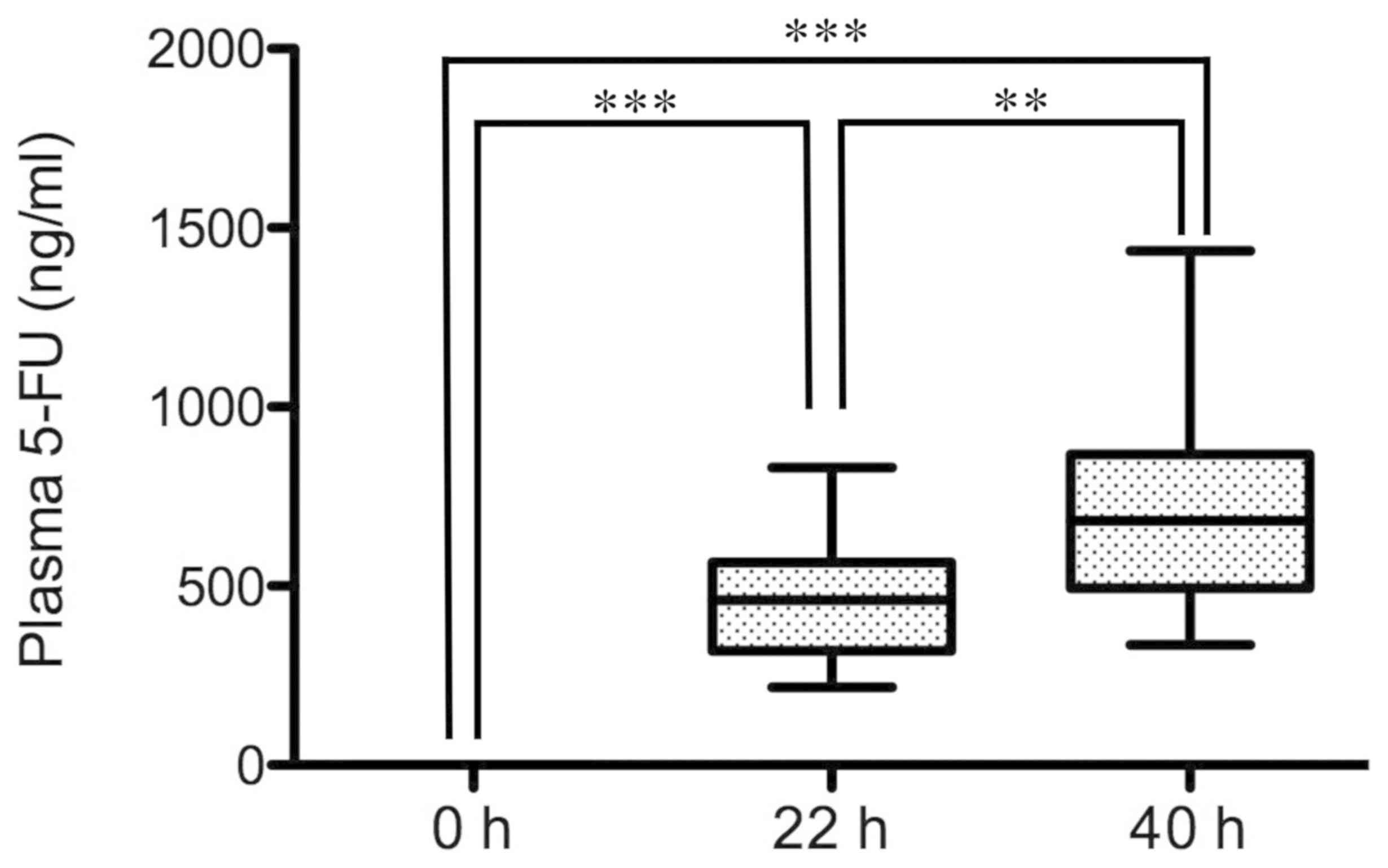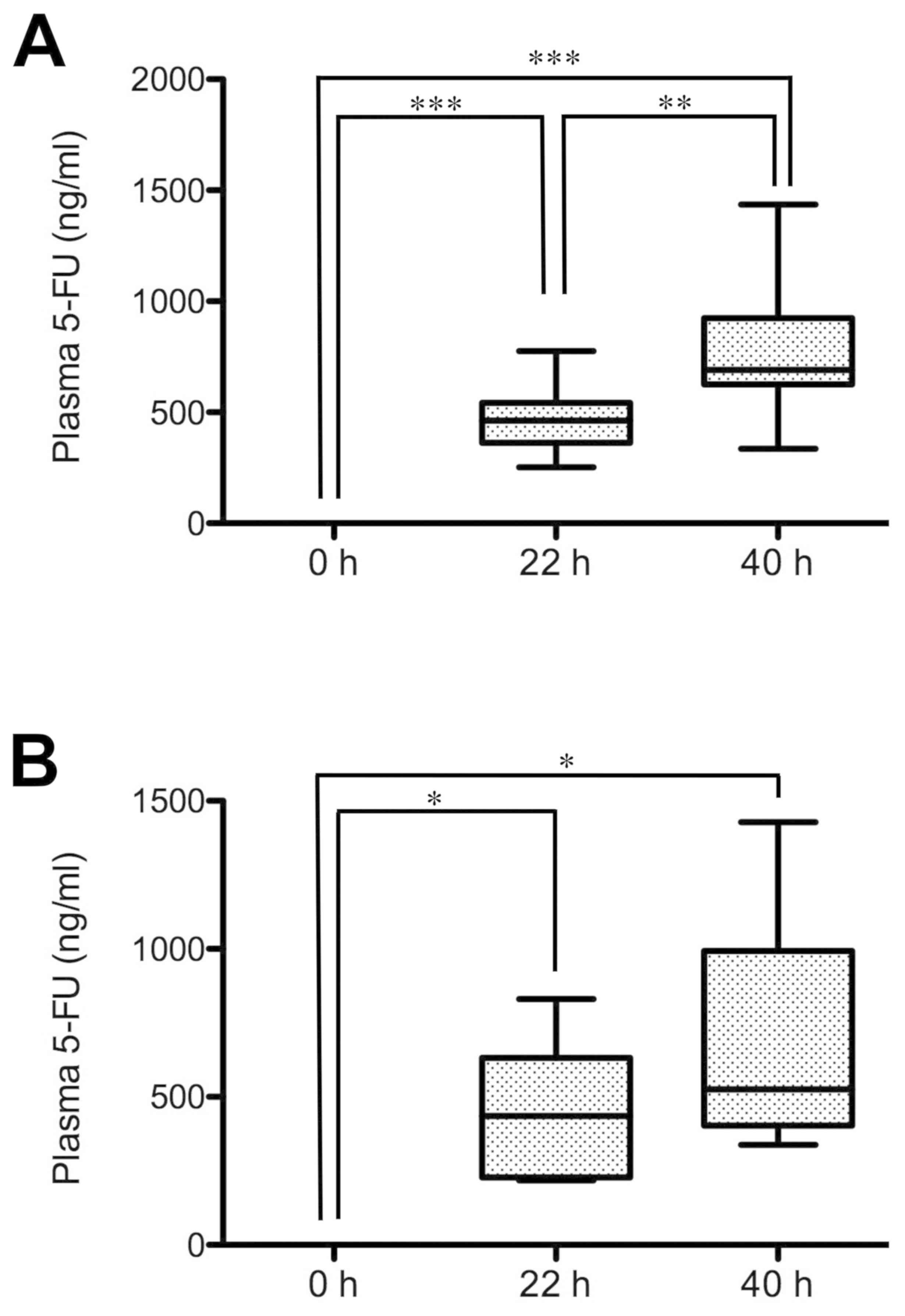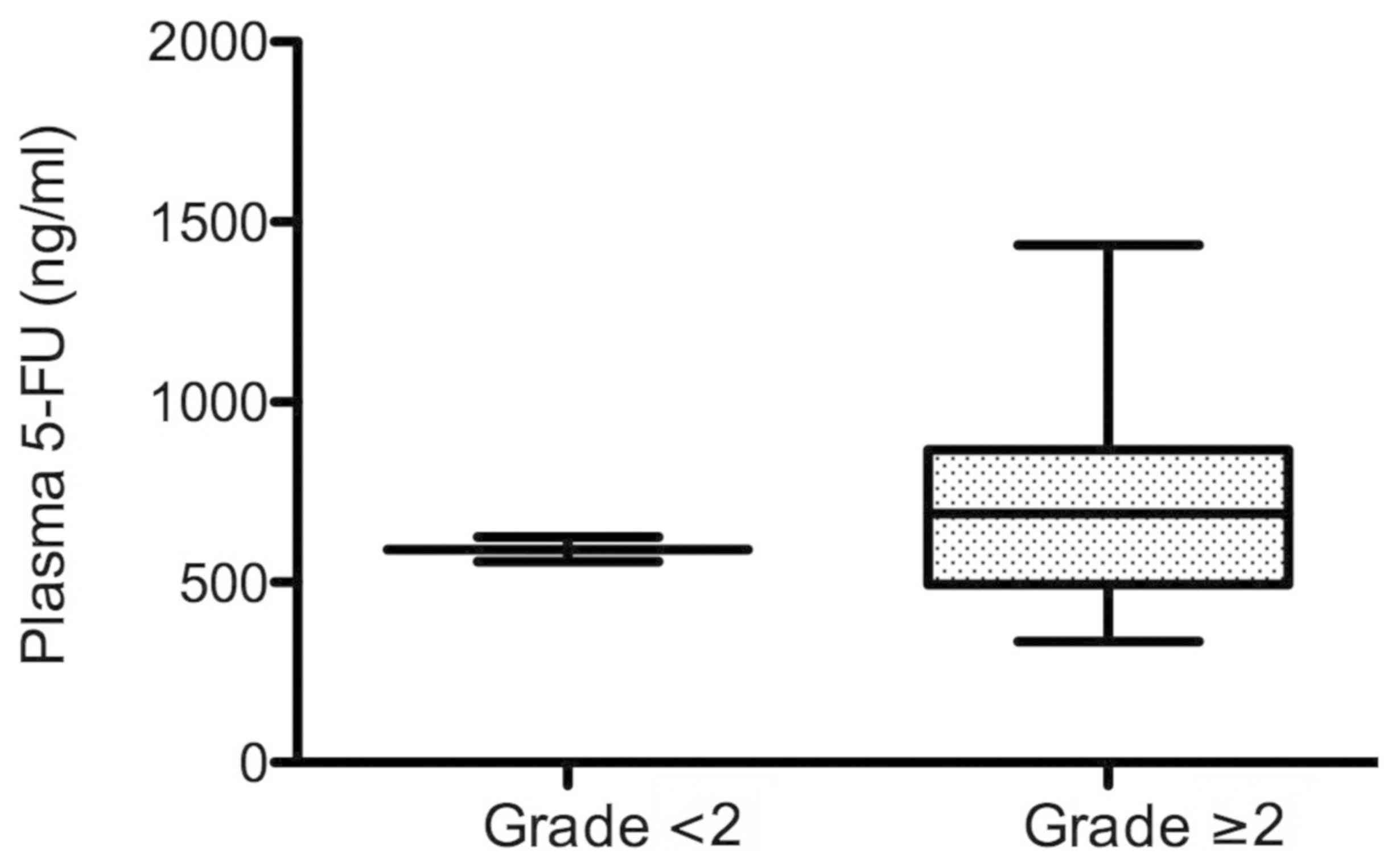|
1
|
Ferlay J, Soerjomataram I, Dikshit R, Eser
S, Mathers C, Rebelo M, Parkin DM, Forman D and Bray F: Cancer
incidence and mortality worldwide: Sources, methods and major
patterns in GLOBOCAN 2012. Int J Cancer. 136:E359–E386. 2015.
View Article : Google Scholar : PubMed/NCBI
|
|
2
|
Benson AB III, Venook AP, Cederquist L,
Chan E, Chen YJ, Cooper HS, Deming D, Engstrom PF, Enzinger PC,
Fichera A, et al: Colon cancer, version 1.2017, NCCN clinical
practice guidelines in oncology. J Natl Compr Canc Netw.
15:370–398. 2017. View Article : Google Scholar : PubMed/NCBI
|
|
3
|
Mayer RJ: Moving beyond fluorouracil for
colorectal cancer. N Engl J Med. 343:963–964. 2000. View Article : Google Scholar : PubMed/NCBI
|
|
4
|
de Gramont A, Figer A, Seymour M, Homerin
M, Hmissi A, Cassidy J, Boni C, Cortes-Funes H, Cervantes A, Freyer
G, et al: Leucovorin and fluorouracil with or without oxaliplatin
as first-line treatment in advanced colorectal cancer. J Clin
Oncol. 18:2938–2947. 2000. View Article : Google Scholar : PubMed/NCBI
|
|
5
|
Saltz LB, Cox JV, Blanke C, Rosen LS,
Fehrenbacher L, Moore MJ, Maroun JA, Ackland SP, Locker PK, Pirotta
N, et al: Irinotecan plus fluorouracil and leucovorin for
metastatic colorectal cancer. Irinotecan Study Group. N Engl J Med.
343:905–914. 2000. View Article : Google Scholar : PubMed/NCBI
|
|
6
|
Tournigand C, Andre T, Achille E, Lledo G,
Flesh M, Mery-Mignard D, Quinaux E, Couteau C, Buyse M, Ganem G, et
al: FOLFIRI followed by FOLFOX6 or the reverse sequence in advanced
colorectal cancer: A randomized GERCOR study. J Clin Oncol.
22:229–237. 2004. View Article : Google Scholar : PubMed/NCBI
|
|
7
|
Cunningham D, Humblet Y, Siena S, Khayat
D, Bleiberg H, Santoro A, Bets D, Mueser M, Harstrick A, Verslype
C, et al: Cetuximab monotherapy and cetuximab plus irinotecan in
irinotecan-refractory metastatic colorectal cancer. N Engl J Med.
351:337–345. 2004. View Article : Google Scholar : PubMed/NCBI
|
|
8
|
Hurwitz H, Fehrenbacher L, Novotny W,
Cartwright T, Hainsworth J, Heim W, Berlin J, Baron A, Griffing S,
Holmgren E, et al: Bevacizumab plus irinotecan, fluorouracil, and
leucovorin for metastatic colorectal cancer. N Engl J Med.
350:2335–2342. 2004. View Article : Google Scholar : PubMed/NCBI
|
|
9
|
Jonker DJ, O'Callaghan CJ, Karapetis CS,
Zalcberg JR, Tu D, Au HJ, Berry SR, Krahn M, Price T, Simes RJ, et
al: Cetuximab for the treatment of colorectal cancer. N Engl J Med.
357:2040–2048. 2007. View Article : Google Scholar : PubMed/NCBI
|
|
10
|
Giantonio BJ, Catalano PJ, Meropol NJ,
O'Dwyer PJ, Mitchell EP, Alberts SR, Schwartz MA and Benson AB III;
Eastern Cooperative Oncology Group Study E3200, : Bevacizumab in
combination with oxaliplatin, fluorouracil, and leucovorin
(FOLFOX4) for previously treated metastatic colorectal cancer:
Results from the Eastern Cooperative Oncology Group Study E3200. J
Clin Oncol. 25:1539–1544. 2007. View Article : Google Scholar : PubMed/NCBI
|
|
11
|
Wu M, Rivkin A and Pham T: Panitumumab:
Human monoclonal antibody against epidermal growth factor receptors
for the treatment of metastatic colorectal cancer. Clin Ther.
30:14–30. 2008. View Article : Google Scholar : PubMed/NCBI
|
|
12
|
Peeters M, Price TJ, Cervantes A, Sobrero
AF, Ducreux M, Hotko Y, Andre T, Chan E, Lordick F, Punt CJ, et al:
Randomized phase III study of panitumumab with fluorouracil,
leucovorin, and irinotecan (FOLFIRI) compared with FOLFIRI alone as
second-line treatment in patients with metastatic colorectal
cancer. J Clin Oncol. 28:4706–4713. 2010. View Article : Google Scholar : PubMed/NCBI
|
|
13
|
Saam J, Critchfield GC, Hamilton SA, Roa
BB, Wenstrup RJ and Kaldate RR: Body surface area-based dosing of
5-fluoruracil results in extensive interindividual variability in
5-fluorouracil exposure in colorectal cancer patients on FOLFOX
regimens. Clin Colorectal Cancer. 10:203–206. 2011. View Article : Google Scholar : PubMed/NCBI
|
|
14
|
Patel JN, O'Neil BH, Deal AM, Ibrahim JG,
Sherrill GB, Olajide OA, Atluri PM, Inzerillo JJ, Chay CH, McLeod
HL and Walko CM: A community-based multicenter trial of
pharmacokinetically guided 5-fluorouracil dosing for personalized
colorectal cancer therapy. Oncologist. 19:959–965. 2014. View Article : Google Scholar : PubMed/NCBI
|
|
15
|
Saif MW, Choma A, Salamone SJ and Chu E:
Pharmacokinetically guided dose adjustment of 5-fluorouracil: A
rational approach to improving therapeutic outcomes. J Natl Cancer
Inst. 101:1543–1552. 2009. View Article : Google Scholar : PubMed/NCBI
|
|
16
|
Gamelin E, Boisdron-Celle M, Delva R,
Regimbeau C, Cailleux PE, Alleaume C, Maillet ML, Goudier MJ, Sire
M, Person-Joly MC, et al: Long-term weekly treatment of colorectal
metastatic cancer with fluorouracil and leucovorin: Results of a
multicentric prospective trial of fluorouracil dosage optimization
by pharmacokinetic monitoring in 152 patients. J Clin Oncol.
16:1470–1478. 1998. View Article : Google Scholar : PubMed/NCBI
|
|
17
|
Ychou M, Duffour J, Kramar A, Debrigode C,
Gourgou S, Bressolle F and Pinguet F: Individual 5-FU dose
adaptation in metastatic colorectal cancer: Results of a phase II
study using a bimonthly pharmacokinetically intensified LV5FU2
regimen. Cancer Chemother Pharmacol. 52:282–290. 2003. View Article : Google Scholar : PubMed/NCBI
|
|
18
|
Kaldate RR, Haregewoin A, Grier CE,
Hamilton SA and McLeod HL: Modeling the 5-fluorouracil area under
the curve versus dose relationship to develop a pharmacokinetic
dosing algorithm for colorectal cancer patients receiving FOLFOX6.
Oncologist. 17:296–302. 2012. View Article : Google Scholar : PubMed/NCBI
|
|
19
|
Capitain O, Asevoaia A, Boisdron-Celle M,
Poirier AL, Morel A and Gamelin E: Individual fluorouracil dose
adjustment in FOLFOX based on pharmacokinetic follow-up compared
with conventional body-area-surface dosing: A phase II,
proof-of-concept study. Clin Colorectal Cancer. 11:263–267. 2012.
View Article : Google Scholar : PubMed/NCBI
|
|
20
|
Gamelin E, Delva R, Jacob J, Merrouche Y,
Raoul JL, Pezet D, Dorval E, Piot G, Morel A and Boisdron-Celle M:
Individual fluorouracil dose adjustment based on pharmacokinetic
follow-up compared with conventional dosage: Results of a
multicenter randomized trial of patients with metastatic colorectal
cancer. J Clin Oncol. 26:2099–2105. 2008. View Article : Google Scholar : PubMed/NCBI
|
|
21
|
Cho J, Yoon J, Kim Y, Oh D, Kim SJ, Ahn J,
Suh GY, Nam SJ and Mitchell SA: Linguistic validation of the US
national cancer institute's patient-reported outcomes version of
the common terminology criteria for adverse events in Korean. J
Glob Oncol. 5:1–10. 2019. View Article : Google Scholar
|
|
22
|
Watanabe T, Muro K, Ajioka Y, Hashiguchi
Y, Ito Y, Saito Y, Hamaguchi T, Ishida H, Ishiguro M, Ishihara S,
et al: Japanese society for cancer of the colon and rectum (JSCCR)
guidelines 2016 for the treatment of colorectal cancer. Int J Clin
Oncol. 23:1–34. 2018. View Article : Google Scholar : PubMed/NCBI
|
|
23
|
Correa GT, Bandeira GA, Cavalcanti BG,
Santos FB, Rodrigues Neto JF, Guimaraes AL, Haikal DS and De Paula
AM: Analysis of ECOG performance status in head and neck squamous
cell carcinoma patients: Association with sociodemographical and
clinical factors, and overall survival. Support Care Cancer.
20:2679–2685. 2012. View Article : Google Scholar : PubMed/NCBI
|
|
24
|
Skierka AS and Michels KB: Ethical
principles and placebo-controlled trials-interpretation and
implementation of the Declaration of Helsinki's placebo paragraph
in medical research. BMC Med Ethics. 19:242018. View Article : Google Scholar : PubMed/NCBI
|
|
25
|
Eisenhauer EA, Therasse P, Bogaerts J,
Schwartz LH, Sargent D, Ford R, Dancey J, Arbuck S, Gwyther S,
Mooney M, et al: New response evaluation criteria in solid tumours:
revised RECIST guideline (version 1.1). Eur J Cancer. 45:228–247.
2009. View Article : Google Scholar : PubMed/NCBI
|
|
26
|
Ishiguro S: Pathological diagnosis of
colorectal cancer according to Japanese classification of
colorectal carcinoma. Nihon Rinsho. 69 (Suppl 3):S325–S329.
2011.(In Japanese).
|
|
27
|
Pinedo HM and Peters GF: Fluorouracil:
Biochemistry and pharmacology. J Clin Oncol. 6:1653–1664. 1988.
View Article : Google Scholar : PubMed/NCBI
|
|
28
|
Lu ZH, Zhang R and Diasio RB: Purification
and characterization of dihydropyrimidine dehydrogenase from human
liver. J Biol Chem. 267:17102–17109. 1992.PubMed/NCBI
|
|
29
|
Diasio RB and Lu Z: Dihydropyrimidine
dehydrogenase activity and fluorouracil chemotherapy. J Clin Oncol.
12:2239–2242. 1994. View Article : Google Scholar : PubMed/NCBI
|
|
30
|
Diasio RB and Johnson MR:
Dihydropyrimidine dehydrogenase: Its role in 5-fluorouracil
clinical toxicity and tumor resistance. Clin Cancer Res.
5:2672–2673. 1999.PubMed/NCBI
|
|
31
|
Zahnd D, Aebi S, Rusterholz S, Fey MF and
Borner MM: A randomized crossover trial assessing patient
preference for two different types of portable infusion-pump
devices. Ann Oncol. 10:727–729. 1999. View Article : Google Scholar : PubMed/NCBI
|
|
32
|
Capdevila X, Macaire P, Aknin P, Dadure C,
Bernard N and Lopez S: Patient-controlled perineural analgesia
after ambulatory orthopedic surgery: A comparison of electronic
versus elastomeric pumps. Anesth Analg. 96:414–417, table of
contents. 2003. View Article : Google Scholar : PubMed/NCBI
|
|
33
|
Ganapathy S, Amendola A, Lichfield R,
Fowler PJ and Ling E: Elastomeric pumps for ambulatory patient
controlled regional analgesia. Can J Anaesth. 47:897–902. 2000.
View Article : Google Scholar : PubMed/NCBI
|
|
34
|
Kaye T: Prolonged infusion times with
disposable elastomeric infusion devices. Am J Hosp Pharm.
51:533–534. 1994.PubMed/NCBI
|
|
35
|
Gamelin EC, Danquechin-Dorval EM, Dumesnil
YF, Maillart PJ, Goudier MJ, Burtin PC, Delva RG, Lortholary AH,
Gesta PH and Larra FG: Relationship between 5-fluorouracil (5-FU)
dose intensity and therapeutic response in patients with advanced
colorectal cancer receiving infusional therapy containing 5-FU.
Cancer. 77:441–451. 1996. View Article : Google Scholar : PubMed/NCBI
|
|
36
|
Blaschke M, Blumberg J, Wegner U,
Nischwitz M, Ramadori G and Cameron S: Measurements of 5-FU plasma
concentrations in patients with gastrointestinal cancer: 5-FU
levels reflect the 5-FU dose applied. J Cancer Ther. 3:28–36. 2012.
View Article : Google Scholar
|

















